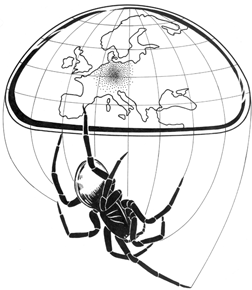Eine bemerkenswerte Beobachtung zur physikalischen Netz-Eigenschaft der Gattung Eresus Walckenaer 1805 (Araneae: Eresidae), gewonnen bei einem Versuch zur Protein-Sequenzierung von Spinnenseide.
A remarkable observation of physical quality of the webs from the genus Eresus Walckenaer, 1805 (Araneae: Eresidae)
spider; web consistance#
On the biology of Dipoena torva (Araneae: Theridiidae)
Zur Biology von Dipoena torva (Araneae: Theridiidae)
Dipoena torva; life history; stratification; pine trees; oaks; Berlin; Germany
Abstract
Data are given concerning stratification, phenology, feeding and mating behaviour of the theridiid spider Dipoena torva (THORELL, 1875). The species was found predominantly at heights of around 10 metres on the stems of oaks and pines in Berlin, Germany. The sex ratio was more or less 1:1. Adult spiders were active during summer whereas juveniles were onliy found before and after the main activity period of adults. This species seems to be active during the daytime. The main food consists of ants. The mating behaviour is described. The occurence of D. torva is a result of certain biotic and abiotic factors such as the abundance of ants, the understorey and structural factors.
Volker Hugenschütt (1997): Bioindikationsanalyse von Uferzonationskomplexen der Spinnen- und Laufkäfergemeinschaften (Arach.: Araneae, Col.: Carabidae) an Fließgewässern im Drachenfelser Ländchen
Volker Hugenschütt (1997): Bioindikationsanalyse von Uferzonationskomplexen der Spinnen- und Laufkäfergemeinschaften (Arach.: Araneae, Col.: Carabidae) an Fließgewässern im Drachenfelser Ländchen
book review
Abstract
book review: Volker Hugenschütt (1997): Bioindikationsanalyse von Uferzonationskomplexen der Spinnen- und Laufkäfergemeinschaften (Arach.: Araneae, Col.: Carabidae) an Fließgewässern im Drachenfelser Ländchen
K.G. Mikhailov: Catalogue of the spiders of the territories of the former Sovjet Union (Arachnida, Aranei)
K.G. Mikhailov: Catalogue of the spiders of the territories of the former Sovjet Union (Arachnida, Aranei)
book review
Abstract
book review: K.G. Mikhailov: Catalogue of the spiders of the territories of the former Sovjet Union (Arachnida, Aranei)
Einige seltene Spinnenarten aus der Slowakei (Araneae)
Records of some rare spiders (Araneae) from Slovakia
Abstract
In South-western Slovakia (Ipel Valley), five rare spider species were found with insufficiently known distribution in Slovakia: Runcinia lateralis (C.L. Koch, 1838 - Thomisidae), Allomengea vidua (O.P.-Cambridge, 1889 - Linyphiidae), Theridion simile C.L. Koch, 1836 (Theridiidae), Gibbaranea ullrichi (Hahn, 1835 - Araneidae), Dolomedes fimbriatus (Clerck, 1757 - Pisauridae).
Spinnengemeinschaften mitteleuropäischer Kulturbiotope
Spider communities of arable land in central Europe
Spiders; spider communities; arable land; zoogeography; colonization strategies
Abstract
This paper contains an analysis of the secies composition and dominance structure of the spider fauna of 13 different arable land sites in Berlin. Investigations were performed by pitfall trapping from April to December 1981. Species composition was extremely uniform despite different microclimatic conditions (soil humidity, light and temperature) and crop types. Only slight differences were found in the composition of abundant species. A multivariate analysis of species, together with microclimatic data, revealed that the measured abiotic factors do not explain the distribution of the species. Nearly all dominant spiders belong to eurytopic species of open habitat t ypes. Spider community descriptions were enhanced by evaluation of references concerning the spider fauna of arable land in central Europe. The composition of abundant species was nearly the same throughout the area. This applies to all different arable sites and furthermore to sites which are related to them ecologically (abandoned grassland, field margins, meadows and pastures). A way which spiders may colonize arable land is discussed critically.
Spiders (Araneae) of stony debris in North Bohemia
Spiders (Araneae) of stony debris in North Bohemia
Spiders; stony debris; microclimate; geographic distribution
Abstract
The arachnofauna was studied at five stony debris sites in northern Bohemia. In Central Europe, the northern and montane species inhabiting cold places live not only on mountain tops and peat bogs but also on the lower edges of boulder debris, where air streaming through the system of inner compartments gives rise to an exceedingly cold microclimate. At such cold sites, spiders can live either on bare stones (Bathyphantes simillimus, Wubanoides uralensis), or in the rich layers of moss and lichen (Diplocentria bidentata). Kratochviliella bicapitata exhibits a diplostenoecious occurence in stony debris and on the tree bark. Latithorax faustus and Theonoe minutissima display diplostenoecious occurence in stony debris and on peat bogs. The occurence of the species Scotina celans in the Czech Republic was documented for the first time.
Die Besiedelung einer neugepflanzten Feldhecke durch epigäische Spinnen (Arachnida: Araneae). Ein ökofaunistischer Beitrag zur Kenntnis von Spinnenzönosen agrarwirtschaftlicher Intensivflächen (Schwand im Innkreis, Bezirk Braunau, Oberösterreich)
Die Besiedelung einer neugepflanzten Feldhecke durch epigäische Spinnen (Arachnida: Araneae). Ein ökofaunistischer Beitrag zur Kenntnis von Spinnenzönosen agrarwirtschaftlicher Intensivflächen (Schwand im Innkreis, Bezirk Braunau, Oberösterreich)
book review


